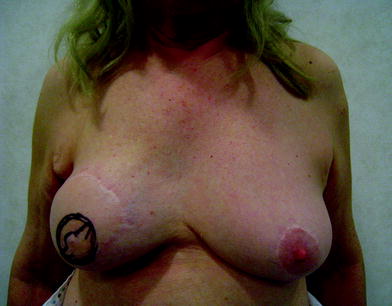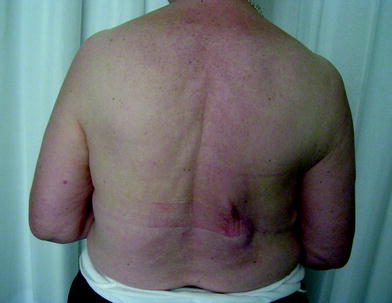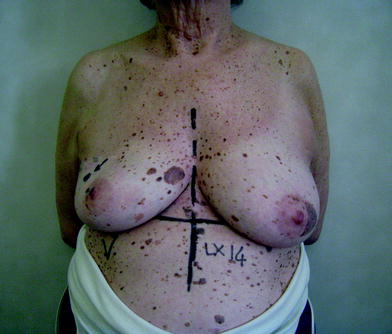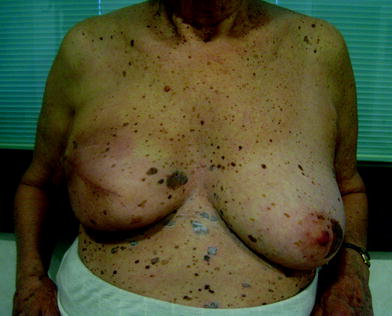Fig. 40.1
A 73-year-old woman after right mastectomy

Fig. 40.2
A 73-year-old woman. Result after delayed reconstruction with a latissimus dorsi flap and planning of nipple–areola complex reconstruction

Fig. 40.3
A 73-year-old woman. Result after latissimus dorsi flap reconstruction (donor site)

Fig. 40.4
A 73-year-old woman. Final result
Implant reconstruction is easy, with a short operating time, no donor site morbidity, and relatively quick recovery. Respecting and evaluation of the vascularity of the mastectomy flaps is mandatory in the immediate setting to prevent marginal flap necrosis, wound dehiscence, secondary healing, and implant exposure. Additional operations after the primary procedure are usually necessary since aesthetic outcomes deteriorate over time [18, 25, 26], but mostly these procedures can be performed with the patient under local anesthesia, including changing and removal of the implant and nipple and areola reconstruction (Figs. 40.5, 40.6).



Fig. 40.5
An 86-year-old woman. Preoperative view

Fig. 40.6
An 86-year-old woman after skin-sparing mastectomy with immediate prosthesis reconstruction
In our experience, flap reconstructions are generally limited to those patients who have received preoperative radiotherapy, since radiation adversely affects the outcomes of implant-based reconstructions, and in those cases of wide mastectomies requiring flap repair. In the future, in the era of perforator flaps reducing donor side morbidity for strength and function, the number of elderly patients requiring this kind of reconstruction will probably increase.
Age alone should not be considered as the sole factor when selecting the type of reconstruction for patients. Nevertheless, comorbidities, the patient’s condition, and concomitant factors together with the patient’s opinion and tumor stage should influence the type of reconstruction. In addition, not all breast cancer patients will definitely required reconstruction. Some elderly patients who are at high risk from surgery refuse reconstructive surgery, and those with limited social lives may prefer an external prosthesis to cope with the mutilation of mastectomy.
Girotto et al. [7] reported that elderly women are less likely to complete nipple–areola complex reconstruction compared with a younger cohort. Our study demonstrated that only 15.5 % of elderly patients completed their reconstructions with the creation of the nipple–areola complex.
40.5.3 Complications
Data from the literature demonstrate that breast reconstruction is safe in elderly patients although it is well known that the risk of perioperative complications is proportionately increased because the number of comorbidities (i.e., hypertension, coronary artery disease, cerebrovascular disease, chronic lung disease, diabetes, and congestive heart failure) [27] and the relative risk of severe complications and death are significantly greater in the geriatric population than in the younger cohort. It is mandatory to address the overall status of the elderly patient when reconstructive options are being considered. Certainly, the overall heath condition, comorbidities, patient expectations and motivations, and tumor stage clearly affect the decision for reconstruction.
In our series [17], most of our elderly patients had an implant-based reconstruction with a low percentage of postoperative complications: no adverse events were observed in the postoperative period. Infection occurred in 6.34 % of patients, partial necrosis of the mastectomy flap in 5.5 %, total implant removal in 12.24 %—due to infection (5.8 %), exposure (1.9 %), or capsular contracture (4.2 %).
In contrast, Lipa et al. [8] reported a series of breast reconstructions in older women, with most of them being autologous flap reconstructions. They described a remarkably high complication rate associated with implant-based reconstructions. Fewer complications resulted from autogenous tissue reconstruction than from prosthetic reconstruction.
Howard-McNatt et al. [28] reported on 89 women older than 60 years having mastectomy and reconstruction (both implants and flaps). They concluded that age should not be a contraindication for breast reconstruction in elderly women.
40.6 Conclusion
Advanced age (in itself) is not a contraindication to breast reconstruction, and breast reconstruction can be successfully performed on well-selected patients. The safety of reconstruction together with improvements in life expectancy increases the incentive to allow older women with breast carcinoma to be reconstructed without major barriers related to age, functional status, and social support. Future cancer research should be conducted in the elderly to provide more confidence in cancer treatment and to decrease undertreatment in elderly patients.









